It feels like everybody is now launching hardware based on the Rockchip RK3576 SoC, the little brother of the RK3588 with Cortex-A72/A53 cores instead of Cortex-A76/A55 cores, 4K video output, and a mid-range Mali-G52 GPU, while keeping most of the same interfaces.
FriendlyELEC has now joined the fray with the NanoPi M5 SBC equipped with up to 4GB LPDDR4x or 16GB LPDDR5, sockets for a UFS module and an M.2 NVMe SSD, HDMI 2.0 and MIPI DSI display interfaces, two MIPI CSI camera connectors, two gigabit Ethernet ports, a 3.5mm audio jack, two USB 3.0 ports, a 30-pin GPIO header, and more.
- SoC – Rockchip RK3576
- CPU – Octa-core CPU with 4x Cortex-A72 cores at 2.2 GHz, 4x Cortex-A53 cores at 2.0 GHz
- GPU – Arm Mali-G52 MC3 GPU with support for OpenGL ES 1.1, 2.0, and 3.2, OpenCL 2.0, and Vulkan 1.2
- NPU – 6 TOPS (INT8) AI accelerator with support for INT4, INT8, INT16, BF16, TF32 mixed operations.
- VPU
- Video Decoder
- H.265, VP9, AV1, and AVS2 up to 8Kp30 or 4Kp120
- H.264/AVC and MJPEG up to 4Kp60
- Video Encoder – H.264, H.265, MJPEG up to 4Kp60
- Video Decoder
- System Memory – 4GB LPDDR4X or 8GB/16GB LPDDR5
- Storage
- 16MB SPI flash
- MicroSD card slot supporting up to UHS-I
- Connectors for UFS 2.0 flash module
- M.2 M-Key 2280 socket for NVMe SSD (PCIe 2.1 x1)
- Video Output
- HDMI 2.0 port up to 4Kp60 or 1080p120
- 4-lane MIPI DSI connector
- Audio
- 3.5mm audio jack for stereo headphone output
- 2.0mm PH-2A connector for analog microphone input
- Digital audio via HDMI
- Camera – 2x 4-Lane MIPI CSI-2 D-PHY v1.2 interfaces
- Networking
- 2x Gigabit Ethernet RJ45 ports via RTL8211F PHYs
- Optional WiFi and Bluetooth via M.2 SDIO module (RTL8822CE recommended, supports AP and STA modes, all OS images provided by FriendlyELEC)
- USB – 2x USB 3.2 Gen 1 Type-A ports
- Expansion – 30-pin 2.54mm GPIO header with 2x SPI, 4x UART, 3x I2C, 1x S/PDIF, 5x PWMs, 20x GPIO
- Debugging – 3-pin Debug UART header; 3.3V level, 1,500,000bps baud rate
- Misc
- Power, Recovery, User, and MASKROM buttons
- Red SYS LED, 2x green user LEDs
- 2-pin 1.27/1.25mm RTC battery input connector for low power RTC IC HYM8563TS
- 5V Fan connector (ZH1.5-2A)
- Boot mode switch
- Power-On mode jumper
- Power Supply – 6V to 20V USB-C port with support for USB PD and DC input
- Dimensions and Weight
- SBC – 90 x 62mm | 58 grams
- Metal case – 94.5 x 68 x 30 mm | 246 grams
- Temperature Range – 0°C to 70°C
FriendlyELEC provides a long list of supported OS and software solutions, namely Alpine Linux, Android 14 Tablet, Buildroot, Debian 12 Core, Debian 11 Desktop, FriendlyWrt 21.02/23.05, OpenMediaVault, Proxmox VE, Ubuntu 20.04/24.04 Desktop, and Ubuntu 24.04 Core. All are currently based on Linux 6.1 LTS and U-boot-2017.09. You’ll find all those OS images, plus hardware and software documentation on the wiki.
Despite its name, the NanoPi M5 is fairly different from the NanoPi M6 (RK3588S) and NanoPi M4B (RK3399), and I don’t expect many of the accessories for the earlier boards to be compatible, except potentially displays, cameras, and M.2 WiFi modules. Its closest competitor is likely the Banana Pi BPI-M5 Pro SBC with a similar set of features and an optional metal case.
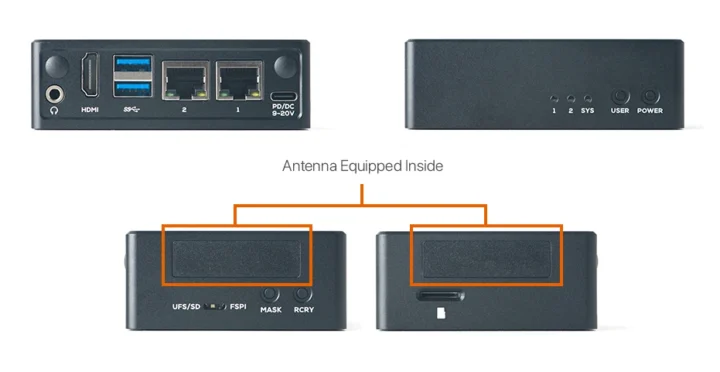
However, the NanoPi M5 is quite cheap, in part because it lacks built-in storage (excluding the SPI flash) and a WiFi 6/BLuetooth module. Pricing starts at $55 for the NanoPi M5 4GB board, and goes up to $110 with 16GB LPDDR5, a metal enclosure, and an M.2 WiFi module. Despite the UFS connector on the board and related documentation on the wiki, I could not find any UFS 2.0 modules for sale on the FriendELEC store at this time.

Jean-Luc started CNX Software in 2010 as a part-time endeavor, before quitting his job as a software engineering manager, and starting to write daily news, and reviews full time later in 2011.
Support CNX Software! Donate via cryptocurrencies, become a Patron on Patreon, or purchase goods on Amazon or Aliexpress. We also use affiliate links in articles to earn commissions if you make a purchase after clicking on those links.


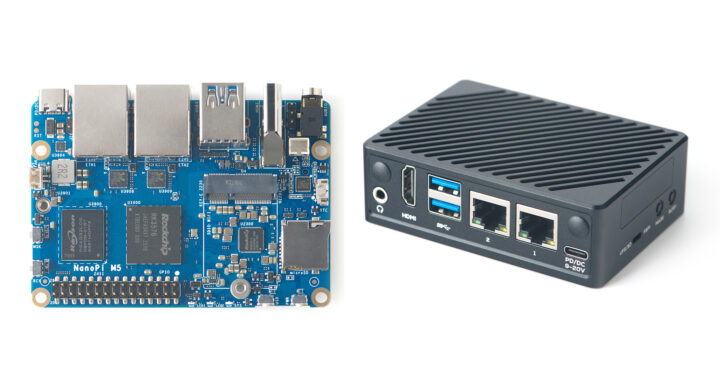
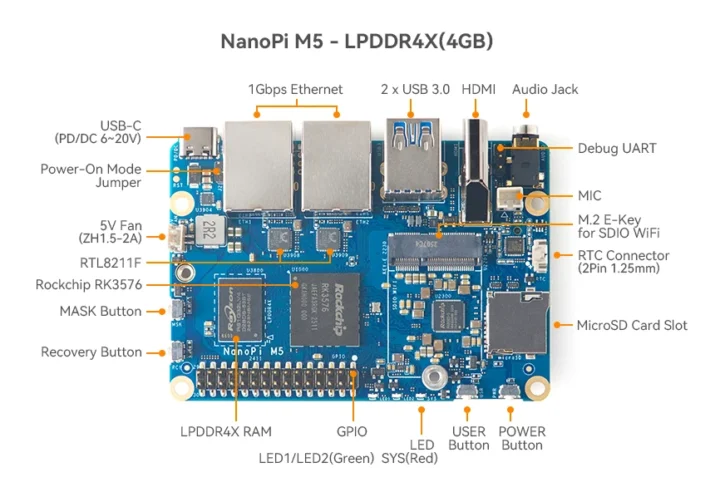
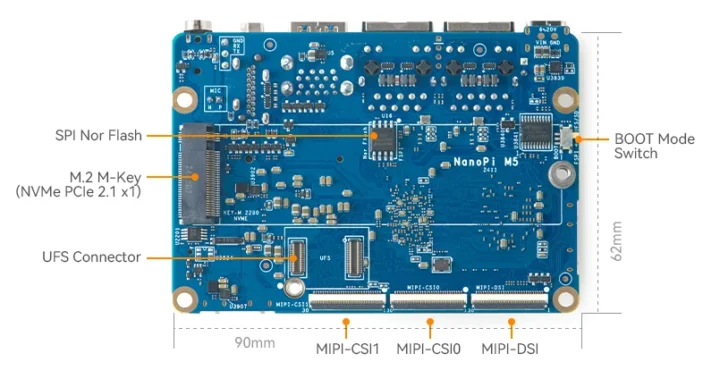
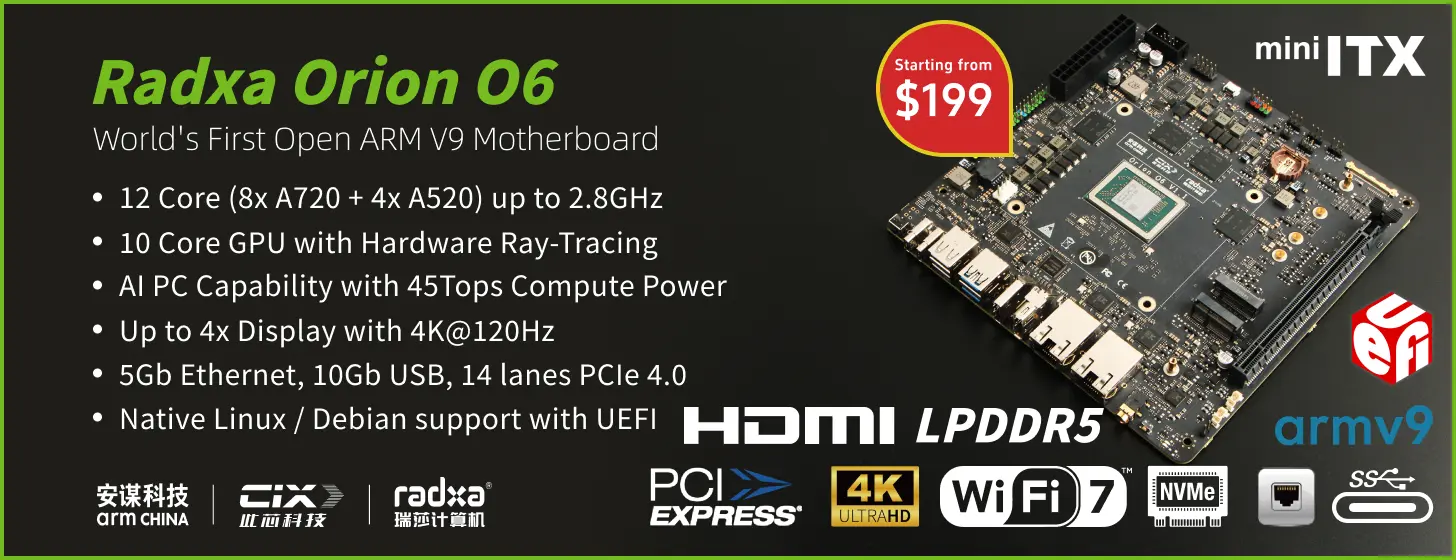


It’s a shame the UFS cards (microSD but fancier) haven’t caught on, at least it would be neat to have design files for that sbc’s module itself.
The Nintendo switch 2 is going to drag everyone into the microsd express era pretty quickly
Why they don’t support 2280?
Eh? See the bottom of the PCB.
The specs read:
> M.2 M-Key 2280 socket for NVMe SSD (PCIe 2.1 x1)
Or did you just look at the M.2 SDIO socket on the top?
I didn’t see 2280 mentioned anywhere.
M2 m can be of different sizes:
2230, 2242, 2260, 2280, 22110
When I don’t see 2280 mentioned, I assume it’s not supported.
Does your browser happen to not support displaying images? XD
https://www.cnx-software.com/wp-content/uploads/2025/05/NanoPi-M5-M2-SSD-UFS-sockets.webp
Didn’t you see the bottom photo ?
BTW in case for any reason you can’t see it, it’s also clearly mentioned on the schematics: https://wiki.friendlyelec.com/wiki/images/9/97/NanoPi_M5_LP5_2411_SCH.pdf (see page 22).
Yes, now I see it officially supports 2280.
I saw, do the picture indicate it’s 2280?
Do this post contains 2280, anywhere?
Yes, in the specs ever since the article was published:
> M.2 M-Key 2280 socket for NVMe SSD (PCIe 2.1 x1)
It’s written in the post, so I thought you wanted a source to confirm this claim. The photo clearly shows a 2280 format, and if you zoom on the photo, on the bottom left corner of the 2280 area, it’s even written “2280”.
I continue not to understand the value of RK3576. It has 9- and 13-year old cores of the era of RK3399, but with half the DRAM bandwidth with twice the number of big cores making the DRAM bandwidth a huge bottleneck (32 bits with 4xA72+4xA53 is even worse than RPi4). RK3582 would bring more single-core and memory performance, with the loss of the HDMI, and RK3588S would probably have approx the same I/O, twice the CPU and DRAM capacity while likely not being that much more expensive. Also IMHO RK3566 and RK3568 do not get all the love they deserve. They have good I/O, low power draw, and decent CPU perf even though not exceptional (A55), which is compensated by a much faster memory controller. Whenever I see castrated devices like above I think that an RK356x would have been a better fit.
Yeah makes more sense to buy the M6 which has the RK3588S
> I continue not to understand the value of RK3576
See https://nitter.net/BG5USN/status/1767000716709609521 for example and especially check the pictures (different ‘master’ OS instances on each cluster). Nothing targeted at the ‘SBC world’ though…
The RK3576 has very similar features to the RK3588S. So, if an application does not require as much processing power, the RK3576 offers a better performance/cost ratio.
> So, if an application does not require as much processing power, the RK3576 offers a better performance/cost ratio.
But then so does a 3528 or a 3328. I mean, here it’s not just about processing power but also about using *old* hence less efficient technologies.
should be 8nm… ?
@Jean, on last paragraph, you misspell BLuetotoh.
BTW, I’ll get RK3588 orangepi plus 16GB rather than this.